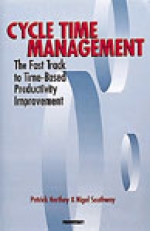Tab Article
As much as 90 percent of the operational activities in a traditional plant are often nonessential or pure waste. Cycle Time Management gives you an exact methodology for eliminating most, if not all, of this waste within 24 to 30 months. Written by the developers of Cycle Time Management(CTM), this book gives you the means to measure productivity in terms of time instead of revenue or people.
By reducing cycle time?the time from initial product concept to the first satisfied customer?you can increase your output of saleable product while you reduce inventories and required working capital. CTM is a cohesive management strategy that integrates just in-time (JIT) production, computer integrated manufacturing (CIM), and total quality control (TQC). This book presents a fully detailed process for CTM implementation.
It includes:
How CTM eliminates waste before CIM is implemented
How CTM measurement of time and processes relate to the practice of ABC accounting
How plant layout, changeover, maintenance, order entry, purchasing, engineering, and distribution contribute to cycle time reduction.
From this succinct, highly focused book, you'll learn what CTM is, how to implement it, and how to manage it. Case studies, over 40 illustrations, and straightforward language make this a book you can use to enlighten your entire work force.


